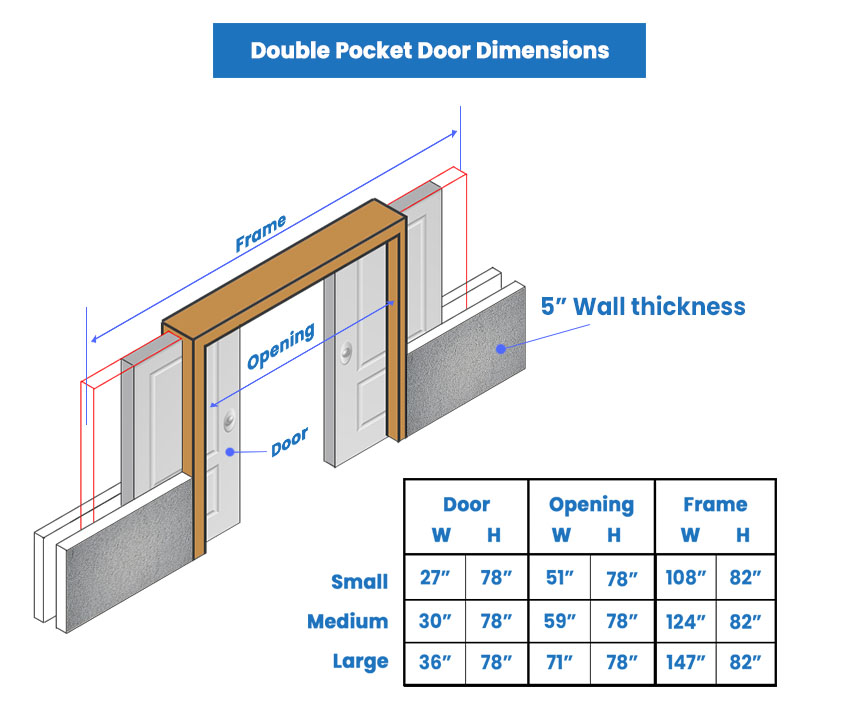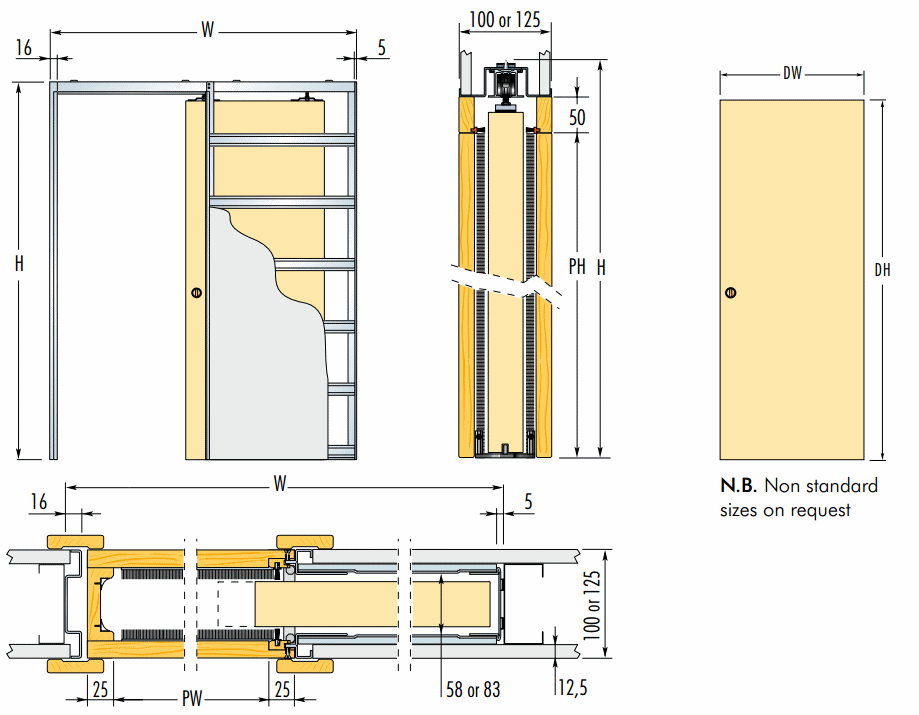Standard Bathroom Pocket Door Dimensions

Pocket doors are a popular choice for bathrooms, offering space-saving functionality and a sleek aesthetic. Their design allows them to slide into a hidden compartment within the wall, eliminating the need for swing space. This makes them particularly useful in smaller bathrooms or when maximizing space is a priority.
Standard Pocket Door Dimensions
The dimensions of pocket doors are crucial for proper installation and functionality. Understanding the standard sizes helps ensure a seamless fit and optimal performance. The following table showcases common pocket door sizes for bathrooms, including both single and double configurations:
| Door Type | Width | Height | Rough Opening |
|---|---|---|---|
| Single Pocket Door | 24″, 28″, 30″, 32″, 36″ | 80″, 84″ | Width + 4″, Height + 2″ |
| Double Pocket Door | 48″, 56″, 60″, 64″, 72″ | 80″, 84″ | Width + 6″, Height + 2″ |
The table highlights the standard dimensions for both single and double pocket doors. Single pocket doors typically have a width ranging from 24 inches to 36 inches, while double pocket doors range from 48 inches to 72 inches. The height is usually 80 inches or 84 inches for both configurations. The rough opening dimensions refer to the size of the wall opening that needs to be created to accommodate the pocket door system. It is important to note that these dimensions are just guidelines, and actual dimensions may vary depending on the manufacturer and specific installation requirements.
Single vs. Double Pocket Doors
The choice between a single and double pocket door depends on the size of the bathroom and the desired functionality. Single pocket doors are suitable for smaller bathrooms, providing access to a single entry point. Double pocket doors, on the other hand, offer greater flexibility and wider openings, allowing for easy access and movement in larger bathrooms. Double pocket doors also provide the option of creating a wider opening for larger furniture or appliances.
Considerations for Pocket Door Dimensions
When choosing pocket door dimensions, it is crucial to consider the following factors:
- Bathroom Size: The size of the bathroom will determine the appropriate size of the pocket door. Smaller bathrooms typically accommodate single pocket doors, while larger bathrooms may benefit from double pocket doors.
- Functionality: The desired functionality of the pocket door should be considered. If frequent access is needed, a wider opening may be preferred.
- Space Constraints: Ensure sufficient space is available within the wall to accommodate the pocket door system. The rough opening dimensions should be carefully measured to avoid any interference or obstruction.
By considering these factors, you can choose the optimal pocket door dimensions that meet your specific needs and enhance the functionality and aesthetics of your bathroom.
Factors Influencing Bathroom Pocket Door Dimensions

The dimensions of a bathroom pocket door are influenced by various factors, including the size of the bathroom, the location of the door, and the intended use of the space. Understanding these factors helps ensure that the chosen dimensions are suitable and create a functional and aesthetically pleasing bathroom.
Impact of Bathroom Size, Bathroom pocket door dimensions
The size of the bathroom plays a significant role in determining the appropriate dimensions of a pocket door. Smaller bathrooms require doors with narrower widths and heights to maximize available space. Larger bathrooms, on the other hand, allow for wider and taller doors, creating a more spacious feel.
- In small bathrooms, a pocket door with a width of 24 inches and a height of 80 inches is often a suitable choice. This dimension allows for easy access while minimizing the space occupied by the door when it is open.
- Larger bathrooms can accommodate wider and taller doors, such as a 30-inch wide and 84-inch tall pocket door. These dimensions provide a more generous entrance and enhance the overall aesthetic appeal of the bathroom.
Impact of Door Location
The location of the pocket door within the bathroom also affects the optimal dimensions. If the door is located in a tight space, such as a small shower enclosure, a narrower door might be necessary to prevent obstruction. Conversely, a door leading to a larger area, like a bathtub or a walk-in shower, can be wider and taller.
- For a shower enclosure, a 24-inch wide pocket door is typically sufficient. This width allows for easy access while minimizing the space occupied by the door when it is open.
- For a bathtub or a walk-in shower, a wider door, such as a 30-inch wide pocket door, can be more convenient and provide a more spacious entrance.
Impact of Intended Use
The intended use of the bathroom also influences the choice of pocket door dimensions. If the bathroom is primarily used for showering, a narrower door might suffice. However, if the bathroom is also used for bathing or for storing items, a wider door might be necessary to accommodate larger items or to provide easier access.
- A bathroom primarily used for showering can accommodate a 24-inch wide pocket door. This dimension allows for easy access and minimizes the space occupied by the door when it is open.
- A bathroom used for bathing or for storing items can benefit from a wider door, such as a 30-inch wide pocket door. This width provides more space for movement and allows for easier access to larger items.
Comparison with Swinging Doors
Swinging doors require more space than pocket doors. They swing outwards, occupying valuable floor space, which can be a concern in smaller bathrooms. Pocket doors, on the other hand, slide into the wall, eliminating the need for additional floor space.
- Swinging doors typically require a minimum of 36 inches of clear space in front of the door to swing open fully. This can be a significant amount of space, especially in smaller bathrooms.
- Pocket doors, in contrast, require only the space needed for the door to slide into the wall. This can be a significant advantage in small bathrooms, where space is at a premium.
Impact of Door Materials
Different door materials have varying thicknesses, which can affect the overall dimensions of a pocket door. Wood doors are typically thicker than glass or metal doors, requiring a deeper pocket for the door to slide into.
- Wood doors typically have a thickness of 1 3/8 inches or 1 3/4 inches. This thickness requires a deeper pocket for the door to slide into.
- Glass and metal doors are generally thinner than wood doors, requiring a shallower pocket. Glass doors can be as thin as 1/4 inch, while metal doors can be as thin as 1/8 inch.
Designing and Installing Bathroom Pocket Doors: Bathroom Pocket Door Dimensions

Installing a pocket door in your bathroom can enhance space efficiency and add a touch of modern elegance. The process involves careful planning and execution to ensure a smooth and functional installation. This section Artikels the key steps involved in designing and installing a bathroom pocket door.
Designing a Bathroom Pocket Door
Designing a bathroom pocket door involves determining the appropriate dimensions, selecting the right materials, and considering the overall aesthetic.
- Door Size: The standard width for bathroom pocket doors is 24 inches, while the height can vary depending on the ceiling height. It’s essential to consider the available space for the pocket and the overall bathroom layout.
- Door Material: Bathroom pocket doors are typically made of solid wood, hollow-core wood, or composite materials. Wood doors offer durability and a classic look, while composite doors provide moisture resistance and affordability.
- Pocket Frame: The pocket frame is the structure that houses the door when it slides into the wall. It is typically made of wood or metal and must be strong enough to support the weight of the door.
- Door Frame: The door frame surrounds the opening and provides a finished look. It is typically made of wood and should match the style of the door.
- Hardware: The hardware includes the handle, hinges, and track. Select hardware that complements the style of the door and ensures smooth operation.
Installing a Bathroom Pocket Door
Installing a bathroom pocket door requires precision and attention to detail. The following steps provide a comprehensive guide:
- Prepare the Opening: Measure the opening and ensure it is the correct size for the door. Remove any existing trim or molding.
- Install the Pocket Frame: The pocket frame is installed first. Ensure it is level and plumb.
- Install the Door Frame: Install the door frame around the opening, ensuring it is flush with the wall.
- Install the Door: Attach the door to the hinges and slide it into the pocket frame.
- Install the Hardware: Attach the handle, track, and any other hardware.
- Finish the Installation: Trim the opening, install any necessary molding, and paint or stain the door and frame.
Visual Illustration of a Bathroom Pocket Door Installation
[Image of a bathroom pocket door installation showing the pocket frame, door frame, door, and hardware]
The illustration highlights the key components of a bathroom pocket door installation. The pocket frame is located inside the wall and houses the door when it is slid open. The door frame surrounds the opening and provides a finished look. The door slides along the track, and the hardware includes the handle, hinges, and rollers.
Essential Steps for Installing a Bathroom Pocket Door
| Step | Tools | Materials | Safety Precautions |
|---|---|---|---|
| Prepare the Opening | Tape measure, level, saw, hammer, pry bar | Door, pocket frame, door frame, hardware | Wear safety glasses and gloves. Use caution when using power tools. |
| Install the Pocket Frame | Level, plumb bob, stud finder, drill, screws | Pocket frame, screws, shims | Ensure the pocket frame is securely attached to the wall studs. Use caution when drilling into walls. |
| Install the Door Frame | Level, plumb bob, drill, screws | Door frame, screws, shims | Ensure the door frame is level and plumb. Use caution when drilling into walls. |
| Install the Door | Screwdriver, drill, screws | Hinges, screws | Ensure the door is securely attached to the hinges. Use caution when using power tools. |
| Install the Hardware | Screwdriver, drill, screws | Handle, track, rollers, screws | Ensure the hardware is securely attached to the door and frame. Use caution when using power tools. |
| Finish the Installation | Saw, hammer, nail gun, caulk gun | Trim, molding, caulk, paint or stain | Wear safety glasses and gloves. Use caution when using power tools. |
When considering bathroom pocket door dimensions, it’s crucial to remember that they can vary depending on the size of your bathroom and the style of door you choose. For a modern and durable option, you might consider a plastic door for bathroom , which can be lightweight and easy to install.
With proper planning and measurements, your bathroom pocket door will be a functional and stylish addition to your space.
When choosing bathroom pocket door dimensions, consider the overall design aesthetic. A teal and blue bathroom, like the one featured in this stunning design , would benefit from a door that blends seamlessly with the color scheme. Opting for a sleek, modern pocket door in a complementary shade of blue can create a cohesive and elegant look, while maintaining the functionality and space-saving benefits of a pocket door.